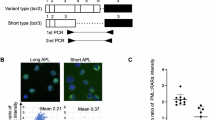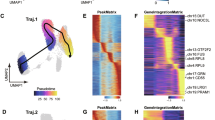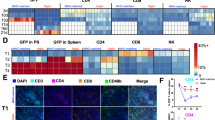Abstract
To understand the mechanisms and identify novel approaches to overcoming retinoic acid (RA) resistance in acute promyelocytic leukaemia (APL), we established the first human RA-resistant APL model in severe combined immunodeficiency (SCID) mice. UF-1 cells, an RA-resistant APL cell line established in our laboratory, were transplanted into human granulocyte-macrophage colony-stimulating factor (GM-CSF)-producing SCID (hGMTg SCID) mice and inoculated cells formed subcutaneous tumours in all hGMTg SCID mice, but not in the non-transgenic control SCID mice. Single-cell suspensions (UF-1/GMTg SCID cells) were similar in morphological, immunological, cytogenetic and molecular genetic features to parental UF-1 cells. All-trans RA did not change the morphological features of cells or their expression of CD11b. RA did not alter the growth curve of cells as determined by MTT assay, suggesting that UF-1/GMTg SCID cells are resistant to RA. These results demonstrate that this is the first RA-resistant APL animal model that may be useful for investigating the biology of this myeloid leukaemia in vivo, as well as for evaluating novel therapeutic approaches including patients with RA-resistant APL.
This is a preview of subscription content, access via your institution
Access options
Subscribe to this journal
Receive 24 print issues and online access
$259.00 per year
only $10.79 per issue
Buy this article
- Purchase on SpringerLink
- Instant access to full article PDF
Prices may be subject to local taxes which are calculated during checkout
Similar content being viewed by others
Author information
Authors and Affiliations
Rights and permissions
About this article
Cite this article
Fukuchi, Y., Kizaki, M., Kinjo, K. et al. Establishment of a retinoic acid-resistant human acute promyelocytic leukaemia (APL) model in human granulocyte-macrophage colony-stimulating factor (hGM-CSF) transgenic severe combined immunodeficiency (SCID) mice. Br J Cancer 78, 878–884 (1998). https://doi.org/10.1038/bjc.1998.596
Issue date:
DOI: https://doi.org/10.1038/bjc.1998.596
This article is cited by
-
A novel therapeutic approach for hematological malignancies based on cellular differentiation and apoptosis
International Journal of Hematology (2002)
-
A novel differentiation-inducing therapy for acute promyelocytic leukemia with a combination of arsenic trioxide and GM-CSF
Leukemia (2001)
-
Arsenic trioxide (As2O3)-induced apoptosis and differentiation in retinoic acid-resistant acute promyelocytic leukemia model in hGM-CSF-producing transgenic SCID mice
Leukemia (2000)



